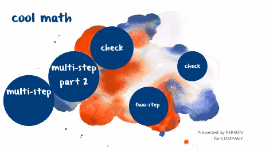Math Powerpoint
Transcript: The population of the Annastasia in 2004 was estimated to be 50,000 people with an annual rate of increase (growth) of about about 5%. We can write f(x)= ab^x, with x as the number of years we would input. 1st Term: 2 2nd Term: 4 3rd Term: 6 4th Term: 8 Arithmetic Sequnce Average Rate of Change Coefficient Discrete Factor Linear Function Range Recursive Slope Term Y-intercept - The change in the value of quantity by the elapsed time. For a function, this is the change in the y-value divided by the change in the x-value for two distinct points on the graph. Function Or No Function? Set B is not a function, since the 4 in the domain pairs with both 5 and 6 in the range. TO FIND THE SLOPE GIVEN TWO POINTS: Discrete Recursive Formula- must know previous term 2,4,6,8,10,12,14,16 Recursive Formula: Geometric For any number x, the numbers that can be evenly divided into x are called factors of x. For example, the number 20 has the factors 1, 2, 4, 5, 10, and 20. Real World Scenerio: Exponential Function Factors of: Alexandria Maddox 5th Term: 10 6th Term: 12 7th Term: 14 8th Term: 16 A formula that requires the computation of all previous terms to find the value of T"n". Coefficient Linear Functions f(x)=20x + 300 f(12)=20*12 + 300 f(12)= 240 + 300 f(12)= 540 marbles Tn=r (Tn-1) 3,9,27,81,_,_ T5=3 (T5-1) T5=3 (81) T5=243 Recursive Y2 - Y1 _______ X2 - X1 Linear and Exponential Functions n= desired sequence d= common difference (could be negative) r= common ratio (could be fraction) For a Geometric Sequence: Tn= r(Tn-1) Alex currently owns 300 marbles in her collection. If she added 20 new marbles each month, how many marbles will she have in a year? The initial value for her function is 300 and the rate of change is 20 per month. With this informtion, we can write f(x)= 20x + 300. To show how to evaluate this function for the number of songs that he would have in one year, we would have in one year, we would input 12 because there are 12 months in one year. * Note: When writing the formula, the only thing you fill in is the T1 and either the d or r. Factor ( - a number multiplied by a variable in an algebraic expression 9/20/12 3rd Block Tn= Tn-1 +d 2,4,6,8,_,_ T5= T5-1 +2 T5= 8 + 2 T5= 10 T5=2(T5-1) = 2(16) T5= 32 > Vocabulary ....... pg.3 Arithmetic Sequence ....... pg.4 Average Rate of Change ......pg.5 Arithmetic Sequence ) 2,5,8,11,_,_,_,_,_ 2,4,8,16,_,_,_,_,_ Arithmetic Sequence Geometric Sequence Tn=Tn-1 +d Tn=r(Tn-1) Summary Unit 3 Recursive Formula: Arithmetic Culminating Activity y = x Real World Scenario: Linear Function Tn=T1(r^n-1) 25,75,225,_,_ T4= 25(3^4-1) T4= 25(27) T4= 675 < y=1 x (2)^x Range pg.3 < Set A is a function, because each domain pairs with exactly one of the range. photo (cc) Malte Sörensen @ flickr Average Rate of Change Throughout this unit I learned more math at one time, than I have ever learned before. I learned about function notation, how to interpret linear and exponential functions arising in application, analyzing linear and exponential functions, building functions, and how to construct and compare linear and exponential models. The easiest was graphing my functions and the hardest was creating real life scenarios.The standard that i have the best grasp is dealing with function notation. Some advice that i would giveto other students that will learn about linear and exponential functions in the future is that you should take lot of notes because that is what really helped me. The task I found most beneficial is when i had to use all four operations to illustrate combinations of linear functions and/or exponential functions. For an Arithmetic Sequence: Tn= T1+ d(n-1) Explicit Formula: Arithmetic The ratio of the vertical and horizontal changes between two points on a surface or a line. TO PLACE ON THE GRAPH: Vocabulary The set of all possible outputs of a function. The range of a relation is the set of all y-coordinates. A shift in which a plane figure moves vertically. Tn= T1+ d(n-1) 7,11,15,19,_,_ T5= 7+4(5-1) T5= 7+16 T5=23 - a sequence of numbers in which the difference between any two consecutive terms is the same Recursive T5=T5-1 +3 = 11 + 3 T5= 14 Explicit Formula- based on the term number. You are able to find the nth term without knowing the previous term. 10: 1, 2, 5, 10 30: 1, 2, 3, 5, 6, 10, 15, 30 40: 1, 2, 4, 5, 8, 10, 20, 40 A function with a constant rate of change and a straight line graph. A value in a sequence--the first value in a sequence is the 1st term, the second value is the 2nd term, and so on; a term is also any of the monomials that make up a polynomial. Which has a greater slope? f(x)=2x+9 or a function representing the number of skittles in a pack where 7 are added each time there is a 2 purlples and 1 red. Arithmetic and Geometric Sequences Vertical Translation Slope Explicit Formula: Geometric Notation: T1= first term in the sequence Tn= the nth term Tn-1= the term BEFORE the nth term d= common difference (could be negative) r= common ratio

















